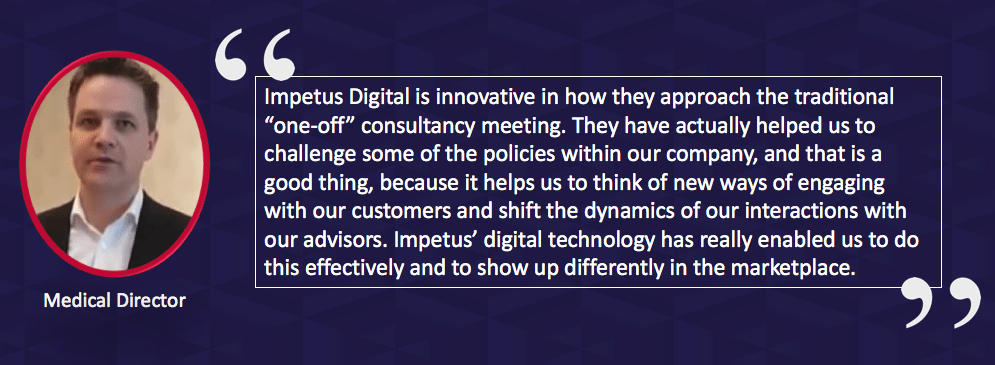In my previous post entitled “Step 1: Isolating your brand’s key issues,”, I discussed the first step in our MIQ Discovery™ process when developing a Longitudinal Expert Engagement Plan™ for your advisors. As discussed, this process involves considering all the possible product and market factors impacting your brand and isolating the top 3-5 issues that are preventing you from capturing “100% market share”. Most importantly, completing this process requires stepping back from day to day concerns and going back to basics. Put differently, you’ll need to figure out why your brand is where it is today.
Describing the Insight Gap(s)
The next step in this process is to take the fundamental brand issues and isolate the insight gaps that remain. Essentially, this refers to the pressing questions or insights that keep you up at night.
The problem is that we often don’t realize how many assumptions we make in our daily activities and customer interactions. We do this simply because there is not enough time or because we just assume we already know the answers. However, sometimes the issue is that we have not taken the opportunity to clearly articulate the questions. In other words, we have not formulated in our minds what is still unknown. Or more importantly, we have not figured out how to concretely describe the queries.
Consequently, there is a need to take a holistic approach to your brand and refocus your attention on the big picture. In some cases, this means going beyond the obvious data, statistics and dashboards of the day. As a result, this type of thinking can inspire us to ask bigger and more provocative questions that go even beyond the “pill” we are marketing or the diagnostics in question.
Describing Your Methodology
After the right questions and insight gaps have been identified, the next step is to determine how to answer these questions. Ask yourself, will you be working internally to solve some issues? Will a new clinical trial be required or meetings set up with global, medical, cross functional or leadership teams? Or do you need some holistic insights that can be derived from market research or focus groups? Perhaps you need to engage with physicians, advisors, consultants, co-authors, patients, payers or other healthcare stakeholders in an advisory board, steering committee or working group. Identifying the most productive “tool” or tactic for answering these questions is crucial in finding the answers you need.
Describing Your Objectives and Metrics
With a solid methodology in place, one must now determine what the objectives will be for specific tactics. Consider what it is that you want to accomplish and what the “call to action” will be. Sometimes determining what your key imperatives are can be achieved by imagining what you want the situation to look like in 6 or 12 months. Ask yourself, will these changes be attitudes that can be measured by changes in people’s intentional awareness or consciousness about specific information? Conversely, will it be a shift in people’s behaviors in light of new data? Or perhaps it will be in the creation of a specific deliverable (i.e. consensus paper, reimbursement dossier, patient education material, etc.) created within a specific budget and timeline.
Often I find this step to be one that many people struggle with. This is due to the fact that clearly stating success metrics for a particular activity can be particularly difficult. This is especially evident when legacy tactics are used, such as sponsoring physicians to a conference. As a result, you need to consider what is the measurement of success. Is it the number of physicians who accepted your sponsorship? Or is it the number of presentations that they give after attending? Or is it a particular behavioral shift you are seeking from them over time? Sometimes it can be several of these benchmarks, including some that are more difficult or time intensive to measure.
One of the reasons for the difficulty in articulating benchmarks is that we have socialized success metrics to fit within very narrow filters, as viewed through profit and loss statements. Indeed, it is much more difficult to measure “validated learning,” as Eric Ries’ suggests in his book “Lean Startup“. Moreover, it is equally difficult to measure the impact of social media on marketing efforts. This is because metrics are often difficult to quantify due to the lack of comparables. This is particularly true if no specific benchmarks exist for a particular intervention or tactic. Although benchmark data is often available, you may not have access to it organizationally or know where to locate that information. If this is the case, coming up with surrogate benchmarks or even benchmark estimates, is the most reasonable approach when creating success metrics.
At Impetus Digital, we feel strongly about clearly mapping out your success path to provide you with a structured approach and direction. Indeed, we know from our 10+ years of building and managing our clients’ advisory boards and steering committees exactly which benchmarks you should be comparing your programs to. These benchmarks take into consideration the customer engagement rates, quantity and quality of insights shared, the speed at which to gather insights or get projects completed, as well as cost savings in comparison to more traditional customer engagement activities, such as in-person consultancy meetings.


Homework time!
Want to skip ahead? Curious how this actually works?
Sign up for a special complimentary, no obligation, personalized one-on-one web meeting demonstration to see how the MIQ Discovery™ process works, and how our best-in-class virtual collaboration tools can be leveraged for your next advisory board or steering committee.




